Preventing Pressure Injury at Marian Hospital: Action Plan
VerifiedAdded on 2020/04/13
|7
|1058
|89
Report
AI Summary
This report provides a comprehensive action plan for preventing pressure injuries at Marian Hospital, emphasizing the significant financial and health implications associated with these injuries. The plan focuses on educating nurses about evidence-based practices, product choices, and strategic interventions. It highlights the importance of thorough skin assessments using tools like the Braden scale to identify patients at risk. The plan includes regular skin checks, pressure ulcer staging, and the use of the Waterlow form in emergency departments. Essential interventions involve providing pressure-relieving mattresses and adhering to repositioning protocols, including two-hour repositioning for bedridden patients. The report underscores the crucial role of high-quality nursing care and clinician education in preventing pressure injuries, with references to support the evidence-based strategies. This action plan aims to improve patient outcomes and reduce the incidence of hospital-acquired pressure ulcers through proactive and informed nursing practices.
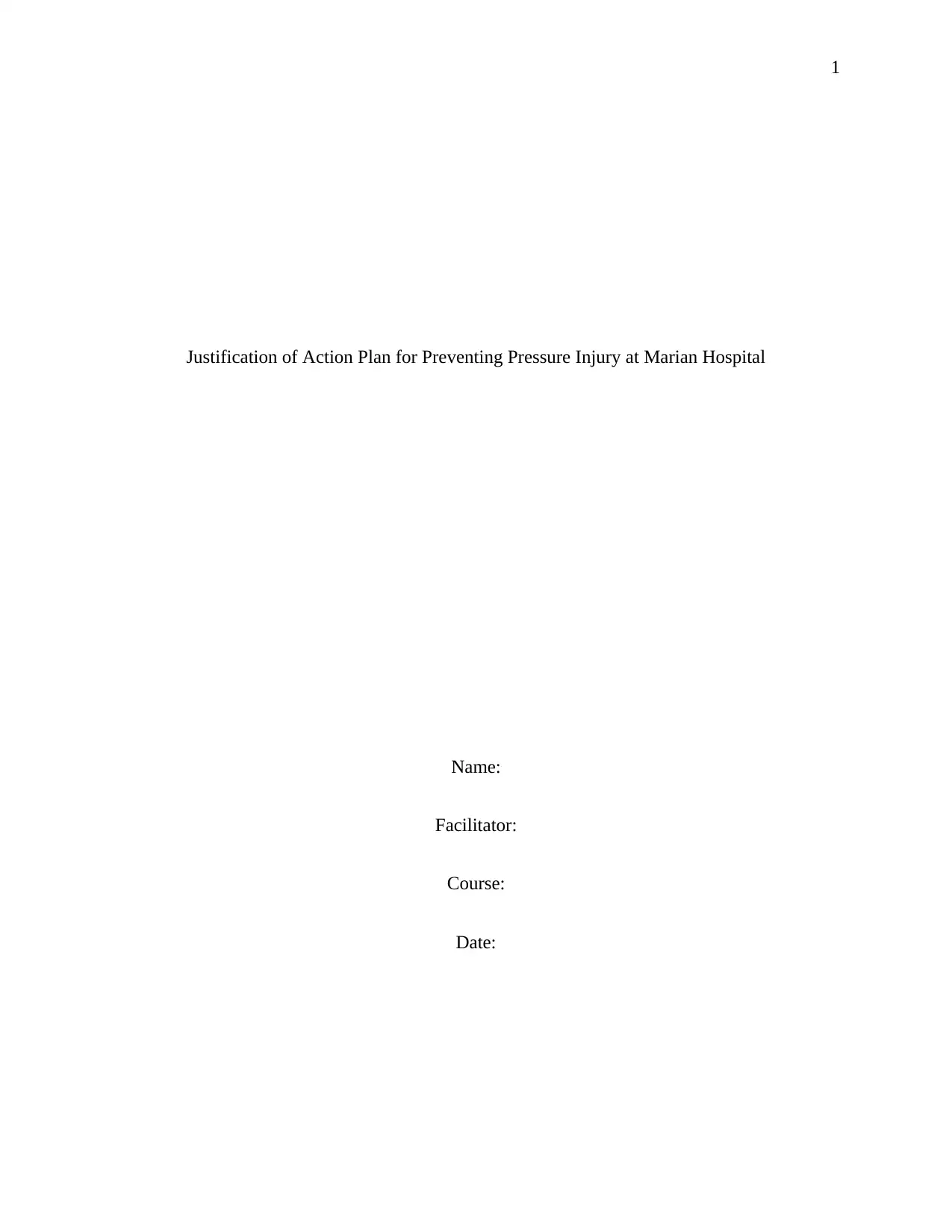
1
Justification of Action Plan for Preventing Pressure Injury at Marian Hospital
Name:
Facilitator:
Course:
Date:
Justification of Action Plan for Preventing Pressure Injury at Marian Hospital
Name:
Facilitator:
Course:
Date:
Paraphrase This Document
Need a fresh take? Get an instant paraphrase of this document with our AI Paraphraser

2
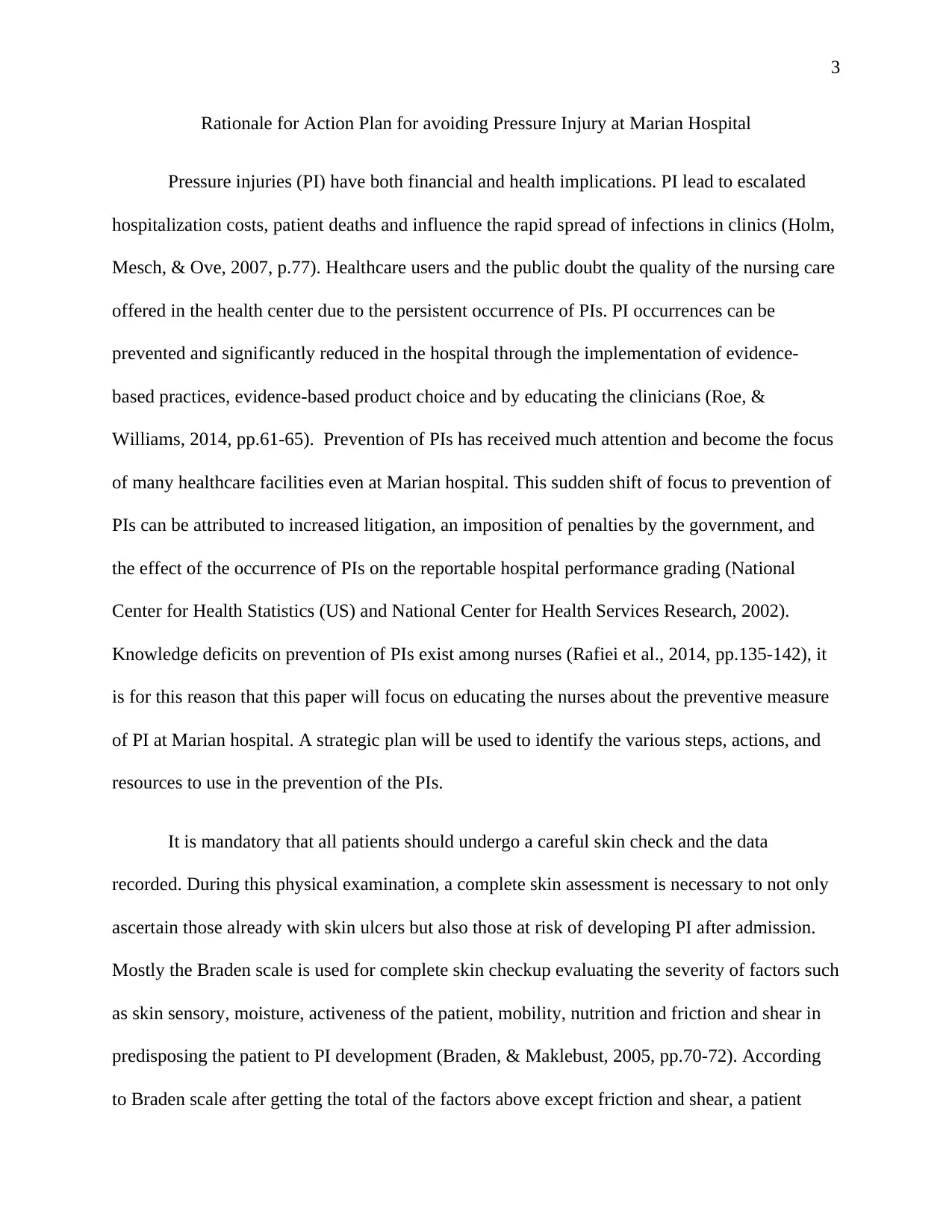
3
Rationale for Action Plan for avoiding Pressure Injury at Marian Hospital
Pressure injuries (PI) have both financial and health implications. PI lead to escalated
hospitalization costs, patient deaths and influence the rapid spread of infections in clinics (Holm,
Mesch, & Ove, 2007, p.77). Healthcare users and the public doubt the quality of the nursing care
offered in the health center due to the persistent occurrence of PIs. PI occurrences can be
prevented and significantly reduced in the hospital through the implementation of evidence-
based practices, evidence-based product choice and by educating the clinicians (Roe, &
Williams, 2014, pp.61-65). Prevention of PIs has received much attention and become the focus
of many healthcare facilities even at Marian hospital. This sudden shift of focus to prevention of
PIs can be attributed to increased litigation, an imposition of penalties by the government, and
the effect of the occurrence of PIs on the reportable hospital performance grading (National
Center for Health Statistics (US) and National Center for Health Services Research, 2002).
Knowledge deficits on prevention of PIs exist among nurses (Rafiei et al., 2014, pp.135-142), it
is for this reason that this paper will focus on educating the nurses about the preventive measure
of PI at Marian hospital. A strategic plan will be used to identify the various steps, actions, and
resources to use in the prevention of the PIs.
It is mandatory that all patients should undergo a careful skin check and the data
recorded. During this physical examination, a complete skin assessment is necessary to not only
ascertain those already with skin ulcers but also those at risk of developing PI after admission.
Mostly the Braden scale is used for complete skin checkup evaluating the severity of factors such
as skin sensory, moisture, activeness of the patient, mobility, nutrition and friction and shear in
predisposing the patient to PI development (Braden, & Maklebust, 2005, pp.70-72). According
to Braden scale after getting the total of the factors above except friction and shear, a patient
Rationale for Action Plan for avoiding Pressure Injury at Marian Hospital
Pressure injuries (PI) have both financial and health implications. PI lead to escalated
hospitalization costs, patient deaths and influence the rapid spread of infections in clinics (Holm,
Mesch, & Ove, 2007, p.77). Healthcare users and the public doubt the quality of the nursing care
offered in the health center due to the persistent occurrence of PIs. PI occurrences can be
prevented and significantly reduced in the hospital through the implementation of evidence-
based practices, evidence-based product choice and by educating the clinicians (Roe, &
Williams, 2014, pp.61-65). Prevention of PIs has received much attention and become the focus
of many healthcare facilities even at Marian hospital. This sudden shift of focus to prevention of
PIs can be attributed to increased litigation, an imposition of penalties by the government, and
the effect of the occurrence of PIs on the reportable hospital performance grading (National
Center for Health Statistics (US) and National Center for Health Services Research, 2002).
Knowledge deficits on prevention of PIs exist among nurses (Rafiei et al., 2014, pp.135-142), it
is for this reason that this paper will focus on educating the nurses about the preventive measure
of PI at Marian hospital. A strategic plan will be used to identify the various steps, actions, and
resources to use in the prevention of the PIs.
It is mandatory that all patients should undergo a careful skin check and the data
recorded. During this physical examination, a complete skin assessment is necessary to not only
ascertain those already with skin ulcers but also those at risk of developing PI after admission.
Mostly the Braden scale is used for complete skin checkup evaluating the severity of factors such
as skin sensory, moisture, activeness of the patient, mobility, nutrition and friction and shear in
predisposing the patient to PI development (Braden, & Maklebust, 2005, pp.70-72). According
to Braden scale after getting the total of the factors above except friction and shear, a patient
⊘ This is a preview!⊘
Do you want full access?
Subscribe today to unlock all pages.

Trusted by 1+ million students worldwide
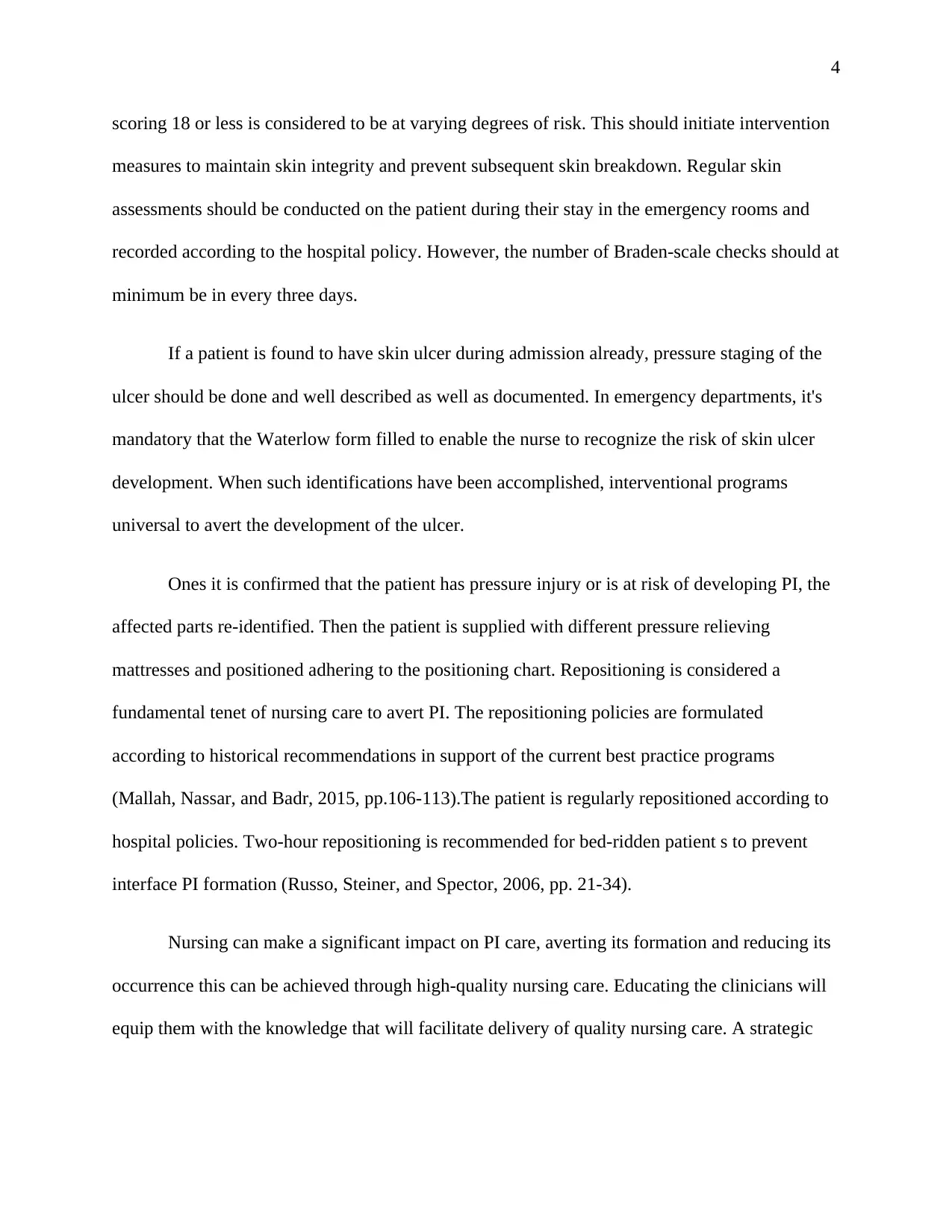
4
scoring 18 or less is considered to be at varying degrees of risk. This should initiate intervention
measures to maintain skin integrity and prevent subsequent skin breakdown. Regular skin
assessments should be conducted on the patient during their stay in the emergency rooms and
recorded according to the hospital policy. However, the number of Braden-scale checks should at
minimum be in every three days.
If a patient is found to have skin ulcer during admission already, pressure staging of the
ulcer should be done and well described as well as documented. In emergency departments, it's
mandatory that the Waterlow form filled to enable the nurse to recognize the risk of skin ulcer
development. When such identifications have been accomplished, interventional programs
universal to avert the development of the ulcer.
Ones it is confirmed that the patient has pressure injury or is at risk of developing PI, the
affected parts re-identified. Then the patient is supplied with different pressure relieving
mattresses and positioned adhering to the positioning chart. Repositioning is considered a
fundamental tenet of nursing care to avert PI. The repositioning policies are formulated
according to historical recommendations in support of the current best practice programs
(Mallah, Nassar, and Badr, 2015, pp.106-113).The patient is regularly repositioned according to
hospital policies. Two-hour repositioning is recommended for bed-ridden patient s to prevent
interface PI formation (Russo, Steiner, and Spector, 2006, pp. 21-34).
Nursing can make a significant impact on PI care, averting its formation and reducing its
occurrence this can be achieved through high-quality nursing care. Educating the clinicians will
equip them with the knowledge that will facilitate delivery of quality nursing care. A strategic
scoring 18 or less is considered to be at varying degrees of risk. This should initiate intervention
measures to maintain skin integrity and prevent subsequent skin breakdown. Regular skin
assessments should be conducted on the patient during their stay in the emergency rooms and
recorded according to the hospital policy. However, the number of Braden-scale checks should at
minimum be in every three days.
If a patient is found to have skin ulcer during admission already, pressure staging of the
ulcer should be done and well described as well as documented. In emergency departments, it's
mandatory that the Waterlow form filled to enable the nurse to recognize the risk of skin ulcer
development. When such identifications have been accomplished, interventional programs
universal to avert the development of the ulcer.
Ones it is confirmed that the patient has pressure injury or is at risk of developing PI, the
affected parts re-identified. Then the patient is supplied with different pressure relieving
mattresses and positioned adhering to the positioning chart. Repositioning is considered a
fundamental tenet of nursing care to avert PI. The repositioning policies are formulated
according to historical recommendations in support of the current best practice programs
(Mallah, Nassar, and Badr, 2015, pp.106-113).The patient is regularly repositioned according to
hospital policies. Two-hour repositioning is recommended for bed-ridden patient s to prevent
interface PI formation (Russo, Steiner, and Spector, 2006, pp. 21-34).
Nursing can make a significant impact on PI care, averting its formation and reducing its
occurrence this can be achieved through high-quality nursing care. Educating the clinicians will
equip them with the knowledge that will facilitate delivery of quality nursing care. A strategic
Paraphrase This Document
Need a fresh take? Get an instant paraphrase of this document with our AI Paraphraser
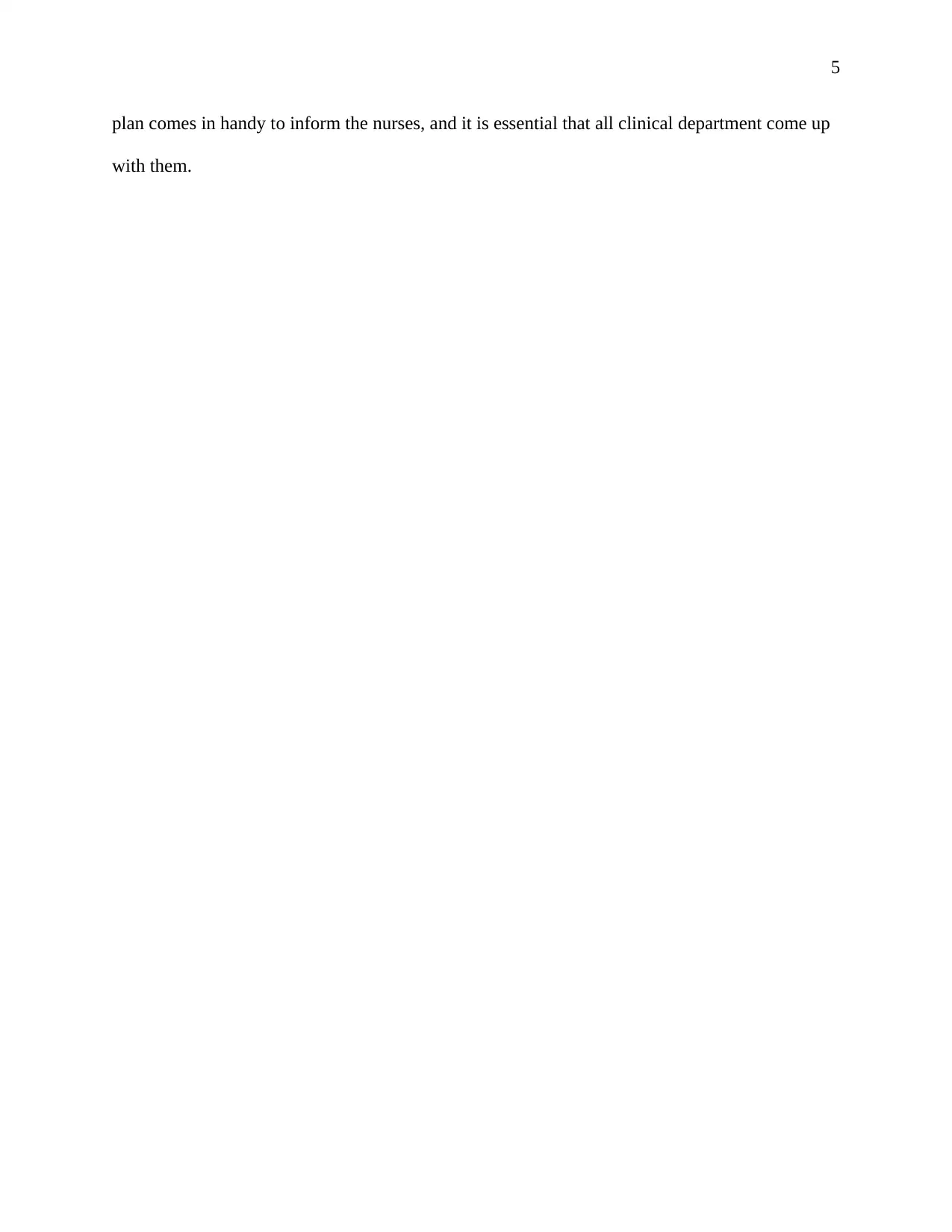
5
plan comes in handy to inform the nurses, and it is essential that all clinical department come up
with them.
plan comes in handy to inform the nurses, and it is essential that all clinical department come up
with them.
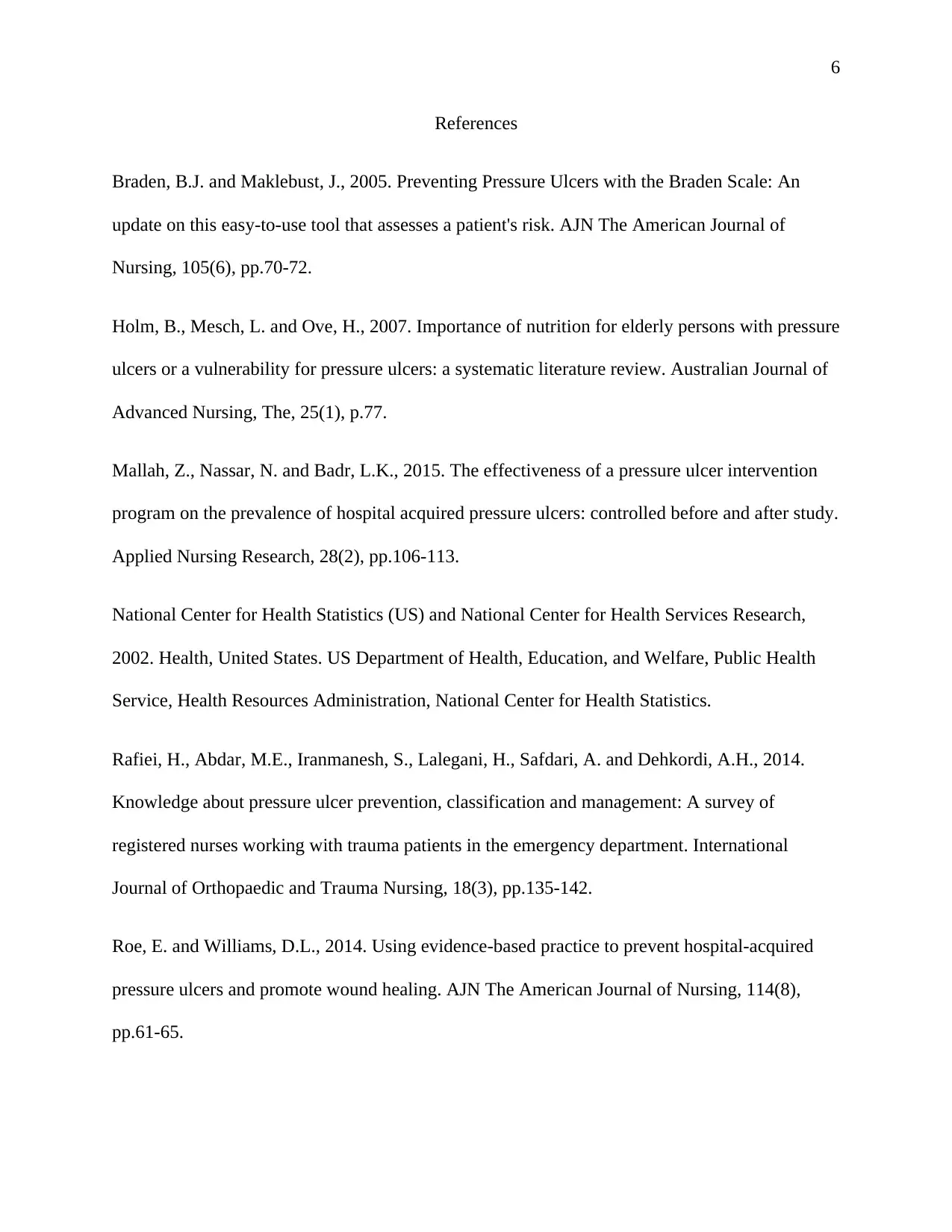
6
References
Braden, B.J. and Maklebust, J., 2005. Preventing Pressure Ulcers with the Braden Scale: An
update on this easy-to-use tool that assesses a patient's risk. AJN The American Journal of
Nursing, 105(6), pp.70-72.
Holm, B., Mesch, L. and Ove, H., 2007. Importance of nutrition for elderly persons with pressure
ulcers or a vulnerability for pressure ulcers: a systematic literature review. Australian Journal of
Advanced Nursing, The, 25(1), p.77.
Mallah, Z., Nassar, N. and Badr, L.K., 2015. The effectiveness of a pressure ulcer intervention
program on the prevalence of hospital acquired pressure ulcers: controlled before and after study.
Applied Nursing Research, 28(2), pp.106-113.
National Center for Health Statistics (US) and National Center for Health Services Research,
2002. Health, United States. US Department of Health, Education, and Welfare, Public Health
Service, Health Resources Administration, National Center for Health Statistics.
Rafiei, H., Abdar, M.E., Iranmanesh, S., Lalegani, H., Safdari, A. and Dehkordi, A.H., 2014.
Knowledge about pressure ulcer prevention, classification and management: A survey of
registered nurses working with trauma patients in the emergency department. International
Journal of Orthopaedic and Trauma Nursing, 18(3), pp.135-142.
Roe, E. and Williams, D.L., 2014. Using evidence-based practice to prevent hospital-acquired
pressure ulcers and promote wound healing. AJN The American Journal of Nursing, 114(8),
pp.61-65.
References
Braden, B.J. and Maklebust, J., 2005. Preventing Pressure Ulcers with the Braden Scale: An
update on this easy-to-use tool that assesses a patient's risk. AJN The American Journal of
Nursing, 105(6), pp.70-72.
Holm, B., Mesch, L. and Ove, H., 2007. Importance of nutrition for elderly persons with pressure
ulcers or a vulnerability for pressure ulcers: a systematic literature review. Australian Journal of
Advanced Nursing, The, 25(1), p.77.
Mallah, Z., Nassar, N. and Badr, L.K., 2015. The effectiveness of a pressure ulcer intervention
program on the prevalence of hospital acquired pressure ulcers: controlled before and after study.
Applied Nursing Research, 28(2), pp.106-113.
National Center for Health Statistics (US) and National Center for Health Services Research,
2002. Health, United States. US Department of Health, Education, and Welfare, Public Health
Service, Health Resources Administration, National Center for Health Statistics.
Rafiei, H., Abdar, M.E., Iranmanesh, S., Lalegani, H., Safdari, A. and Dehkordi, A.H., 2014.
Knowledge about pressure ulcer prevention, classification and management: A survey of
registered nurses working with trauma patients in the emergency department. International
Journal of Orthopaedic and Trauma Nursing, 18(3), pp.135-142.
Roe, E. and Williams, D.L., 2014. Using evidence-based practice to prevent hospital-acquired
pressure ulcers and promote wound healing. AJN The American Journal of Nursing, 114(8),
pp.61-65.
⊘ This is a preview!⊘
Do you want full access?
Subscribe today to unlock all pages.

Trusted by 1+ million students worldwide
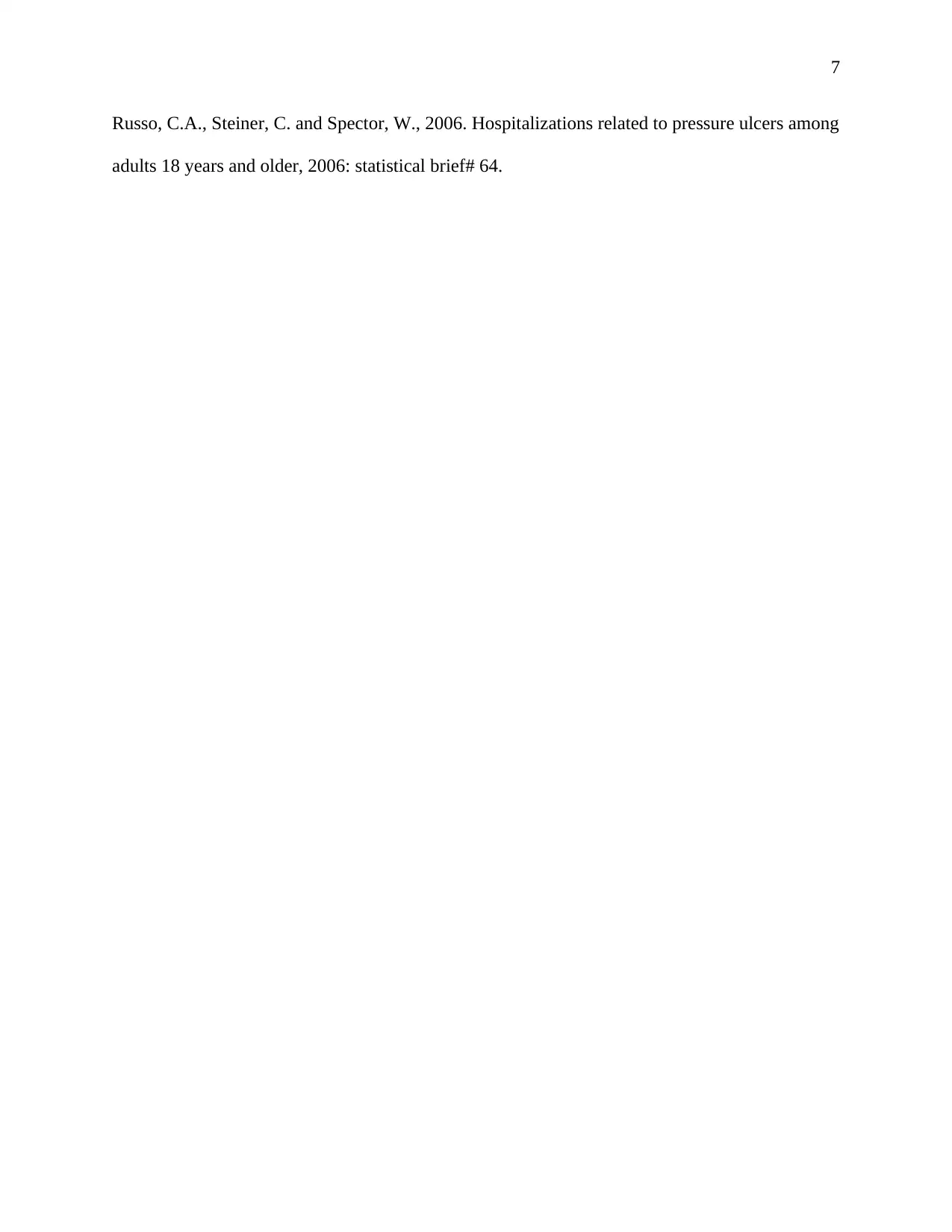
7
Russo, C.A., Steiner, C. and Spector, W., 2006. Hospitalizations related to pressure ulcers among
adults 18 years and older, 2006: statistical brief# 64.
Russo, C.A., Steiner, C. and Spector, W., 2006. Hospitalizations related to pressure ulcers among
adults 18 years and older, 2006: statistical brief# 64.
1 out of 7
Related Documents
Your All-in-One AI-Powered Toolkit for Academic Success.
+13062052269
info@desklib.com
Available 24*7 on WhatsApp / Email
![[object Object]](/_next/static/media/star-bottom.7253800d.svg)
Unlock your academic potential
Copyright © 2020–2025 A2Z Services. All Rights Reserved. Developed and managed by ZUCOL.




